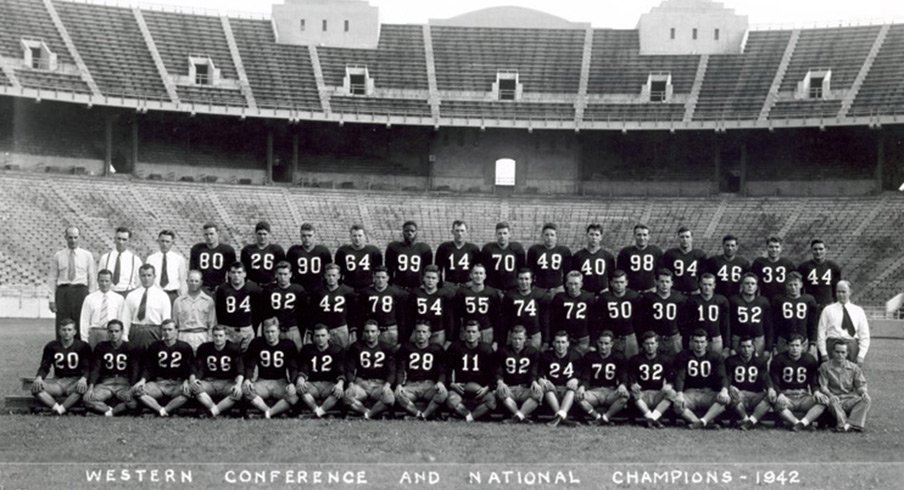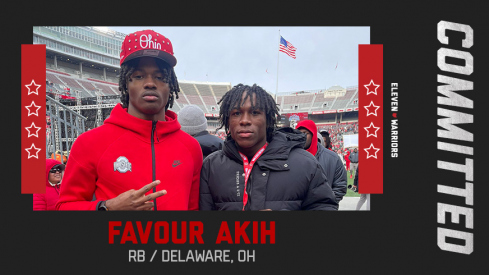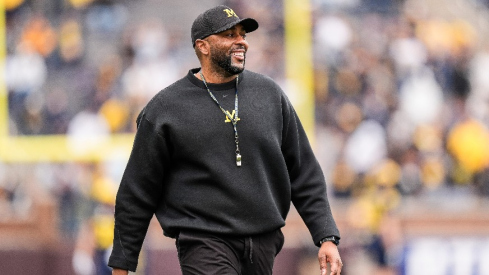Entering The 1942 season, the Buckeyes only had three seniors on the roster. Paul Brown's second team was a young one that was expected to finish no better than third in the Big Ten.
In 1941, Paul Brown's first season as Ohio State's head coach, his Buckeyes had finished 6–1–1. Now 1942, with World War II raging across Europe and the Pacific, many young men in college were leaving school to fight the good fight.
The Buckeyes were not immune as 18 letter-winners did not return to the school for the 1942 season.
With Brown tasked with replacing his entire offensive backfield and more, expectations were tempered for the season.
| The 1942 Buckeyes | |
|---|---|
| Record | 9–1 |
| B1G Record | 5–1, 1st, NATIONAL CHAMPS |
| Coach | Paul Brown (2nd year, 15–2–1) |
| Captain | George Lynn |
Games of Note
September 26th • Fort Knox • Ohio Stadium
With so many military bases fielding football teams at the time, the Big Ten permitted programs to play 10 games instead of eight for the first time in 1942, provided the two extra games would be played against military teams.
Ohio State took advantage of the new rule and scheduled Fort Knox as the first opponent of the season.
The last Saturday of September was a rainy day that left the Ohio Stadium turf to mud. The wet, sloppy track proved beneficial to the Buckeyes as the men of Fort Knox were a little heavy and not in the same physical shape as the Ohio State players.
As part of the scheduling deal, Big Ten schools pledged to donate 10% of gate revenue to the Army and Navy relief funds. Unfortunately, due to the war, only 22,555 fans were on hand for the Fort Knox game to support the cause. Fortunately, though, the donations were for every home game.
| DATE | OPPONENT | LOCATION | RESULT |
|---|---|---|---|
| SEP. 26 | FORT KNOX | OHIO STADIUM | W, 59–0 |
| OCT. 3 | INDIANA | OHIO STADIUM | W, 32–21 |
| OCT. 10 | USC | OHIO STADIUM | W, 28–12 |
| OCT. 17 | PURDUE | OHIO STADIUM | W, 26–0 |
| OCT. 24 | NORTHWESTERN | DYCHE STADIUM | W, 20–6 |
| OCT. 31 | NO. 6 WISCONSIN | CAMP RANDALL | L, 7–17 |
| NOV. 7 | PITT | OHIO STADIUM | W, 59–19 |
| NOV. 14 | NO. 13 ILLINOIS | CLEVELAND | W, 44–20 |
| NOV. 21 | NO. 4 MICHIGAN | OHIO STADIUM | W, 21–7 |
| NOV. 28 | IOWA PRE-FLIGHT | OHIO STADIUM | W, 41–12 |
| 9–1, 337–114 |
October 10th • USC • Ohio Stadium
The week before, Ohio State trailed Indiana, 21-19, after three quarters. Again, the Buckeyes were in better physical shape than their opponent. Brown's squad was able to overcome the 90 degree temperatures and defeat the Hoosiers, 32-21.
In 1941, Ohio State traveled to Los Angeles and trounced the Trojans, 33-0. This time, USC was in Columbus and wanted to return the favor.
The Men of Troy started quickly and went up 6-0 with an early first quarter touchdown. But the Buckeyes bounced back, putting 28 unanswered points on the board. Bob Shaw – who caught two touchdown passes – Bobby Frye and George Lynn found the end zone for the Buckeyes.
Brown's ability to get his team in top physical condition continued to shape games. Ohio State was physically stronger than the Trojans and dominated in the 28-12 win. The nation's largest crowd of the season, 56,436, was on hand to witness the carnage.
| OPPONENT | STREAK | RECORD |
|---|---|---|
| FORT KNOX | W1 | 1–0 |
| INDIANA | W3 | 15–8–3 |
| USC | W2 | 2–2 |
| PURDUE | W3 | 9–1 |
| NORTHWESTERN | W1 | 13–7–1 |
| PITTSBURGH | W3 | 5–2–1 |
| WISCONSIN | L1 | 7–5–2 |
| PITTSBURGH | W3 | 5–2–1 |
| ILLINOIS | W8 | 17–12–2 |
| MICHIGAN | W1 | 11–25–3 |
| IOWA SEAHAWKS | W1 | 1–0 |
October 25th • Northwestern • Dyche Stadium
After beating USC, the Buckeyes, as the No. 1 team in the nation, shut out the Boilermakers and retained the top spot in the AP Poll as the team traveled to Evanston.
In 1941, Pappy Waldorf and his purple Wildcats gave Brown his first, and to this point, only loss as Ohio State's head coach.
Northwestern put up a fight in the first half. The score was tied 0-0 late in the second quarter, when Gene Fekete finally put Ohio State up 7-0 just before halftime.
The defenses reigned in the third quarter as neither team scored. Fekete set-up Ohio State's second touchdown when he intercepted an Otto Graham pass in the fourth period. Sarringhaus finished the ensuing 68-yard drive with a touchdown run from the two yard line on fourth down. The point after was missed and the Buckeyes led 13-0.
Graham made up for the interception when he connected with Nick Vodick for a 28-yard touchdown pass. The Wildcats pulled within a touchdown and now trailed 13-6.
Tommy James and Sarringhaus ensured Ohio State's victory. James pulled in a fourth quarter interception that stopped Northwestern's drive to tie the game. Sarringhaus capped the ensuing drive with a 15-yard touchdown run. He finished the game with 145 rushing yards in the Buckeyes' 20-6 victory.
October 31st • Wisconsin • Camp Randall
With No. 1 Ohio State traveling to face No. 6 Wisconsin, Madison was the epicenter of the sports world on Halloween of 1942. Over 200 radio stations were there to broadcast the game across the nation and the world. The BBC used short wave radio to get the contest to service men in Europe.
45,000 fans packed into Camp Randall Stadium to set a Badgers' record for attendance. They would not leave disappointed.
Head coach Harry Stuhldreher, a native of Massillon, had prepared for this game for a year after Ohio State defeated his Badgers in 1941.
Wisconsin's Pat Harder put the first points on the board when he ran in from eight-yards out. Before the end of the first quarter, he kicked a 37-yard field goal to put the Badgers up 10-0.
In the fourth quarter, Sarringhaus ended a 96-yard drive with a touchdown and cut the score to 10-7. However, Wisconsin immediately answered with another score and went on to defeat Ohio State, 17-7.
Brown's Buckeyes did not play well. Why did the No. 1 team and a group of young men who were in excellent physical condition get outplayed in this game? Dysentery.
Ohio State was forced to take a dilapidated rail car to Wisconsin due to the war, as all first-class rails were not available. The team had to ride in cars that had not been used in many years. Unknown to the team was that the water in the lines had not been replaced. Ohio State's players drank the stale water and it caused a massive case of dysentery within the team.
The trip from hell continued when the Buckeyes arrived in Wisconsin. The team stayed in downtown Madison due to the travel restrictions. The hotel did not have operating elevators and that forced the players to walk six stories to their rooms. Typically, it would be an inconvenience, but with the majority of players struggling with stomach ailments it was a disaster.
Staying in Madison was another mistake. The Badger fans held various pep rallies throughout the night. The noise and ruckus kept the weary Buckeyes from getting a proper night's sleep.
Not to take away from Wisconsin's win, but they did not play Ohio State at full strength. I'm not saying the Buckeyes lost because of dysentery, but the Buckeyes lost because of dysentery.
November 14th • Illinois • Cleveland Municipal Stadium
The week after the Wisconsin loss, a healthier Ohio State throttled Pittsburgh 59-19.
The following week, they'd face Illinois in what was slated as an Illini home game, but was played in Cleveland. The No. 13 Illini were not getting fans to show in Memorial Stadium, so the game was moved to Cleveland at the request of alumni from both schools in the area.
Ray Eliot was in his first season as Illinois' head coach. He replaced Hall of Fame coach, Robert Zuppke, in part because the Illini had lost seven straight games to Ohio State.
This cold-weather game would not turn the tide for Illibuck. In fact, the Fighting Illini lost by the largest margin ever in the series to that point.
Les Horvath, a Cleveland native, made the most of playing in front of his home fans. Horvath completed four passes for 109 yards and a touchdown. He also rushed for another 68 yards.
The impressive 44-20 win brought the Buckeyes back into the AP Poll's top five.
November 21st • Michigan • Ohio Stadium
Michigan came to Columbus fresh off of a 32-20 victory over Notre Dame and had a 6–2 record. The Maize and Blue's two losses were to Iowa Pre-Flight and Minnesota.
The stage was set for the 72,691 fans – Ohio Stadium's largest crowd of 1942 – to watch the No. 5 Buckeyes take on the No. 4 Wolverines. Michigan's coach, Fritz Crisler, was a near-perfect 4–0–1 against Ohio State and his team entered the Shoe full of confidence for a game airing on national radio. Adding to their swagger was the knowledge that Ohio State would be without halfbacks Tommy James, Bill Durtschi, Bobby Frye and Tom Cleary.
It was another cold and rainy game, but the Buckeyes overcame the playing conditions and put it to their rival. Team MVP, Chuck Csuri, blocked a Michigan punt in the second quarter to set the table for Ohio State's first touchdown. Sarringhaus and Shaw connected on a touchdown pass and the Bucks led 14-0 late in the third quarter.
The Wolverines cut the lead to 14-7, but Paul White fumbled the ball and Ohio State's Jabbusch recovered it on Michigan's 32 yard line. This drive ended when Sarringhaus found Horvath for his second touchdown pass of the day. The Buckeyes ended the Wolverines' winning streak with the 21-7 victory and improved to 11–25–3 in the series.
This was the last time Ohio State did not finish the regular season against Michigan.
November 28th • Iowa Pre-Flight • Ohio Stadium
This was the first of two home games against the Iowa Pre-Flight Seahawks. The Seahawks were a Navy team made up of graduated collegiate and former professional players, who traveled the country playing the nation's best teams.
Iowa Pre-Flight came to Columbus with a 7-1 record. One of the seven victories was a 26-14 beating of Michigan in October. The lone loss was to Notre Dame.
The Seahawks were coached by former Minnesota coach, Bernie Bierman, who guided the Gophers to five national championships between 1934 and 1941. Bierman entered the game with a 1–1 record against Ohio State and was striving to get a winning record against the Buckeyes.
Iowa Pre-Flight was a true all-star team. The Seahawks were older, bigger, and stronger than the college kids from Ohio State. However, the Buckeyes were faster. Brown used his team's speed to win 41-12. The victory made an impression on the voters of the AP Poll, but No. 3 Ohio State still needed some help.
National Champs
Entering the game against Iowa Pre-Flight, Ohio State was ranked behind Georgia Tech and Boston College. The Buckeyes needed to defeat the Seahawks and hope for the teams in front of them to lose.
The first domino fell when the Yellow Jackets were smoked by in-state rival Georgia 34-0. The second domino was much less likely to topple because No. 1 Boston College played unranked Holy Cross at Fenway Park.
The Eagles' players expected to win the season finale and booked a party at the swank Coconut Grove. Holy Cross had other plans and destroyed Boston College, 55-12.
The loss might have been the best thing to happen to the players of Boston College. The team cancelled the party and it saved their lives. The Coconut Grove burned to the ground the night of the Holy Cross game. 478 people passed away. Had the party not been cancelled the Boston College team would have suffered casualties.
With the impressive win, and upset losses, Ohio State shot up the rankings to claim its first national championship.
1942 Recap
- Ohio State defeated Fort Knox in the only game played between the institution.
- The Buckeyes beat USC for the second straight season and the first time in Columbus.
- Ohio State beat Otto Graham and Northwestern.
- Dysentery and bad travel plans led Brown and his boys to lose to Wisconsin.
- The Buckeyes defeated Illinois for the eighth-straight game.
- Ohio State beat a Fritz Crisler-coached Michigan team for the first time.
- The Buckeyes finished the 1942 season ranked No. 1 in the AP Poll.
- Chuck Csuri, Gene Fekete, Lin Houston, Paul Sarringhaus and Robert Shaw were named All-Americans.
- Les Horvath, Bill Vickroy and Don McCafferty were selected in the NFL Draft.
The 1942 season was historic. In his second season, Paul Brown brought discipline, competitiveness and a national championship to Columbus.
Brown had his system in place and a dynasty was building. Unfortunately, the talented football players had another side to fight. Many of the Brown's players did not return for the 1943 season as they enlisted for duty in World War II.



